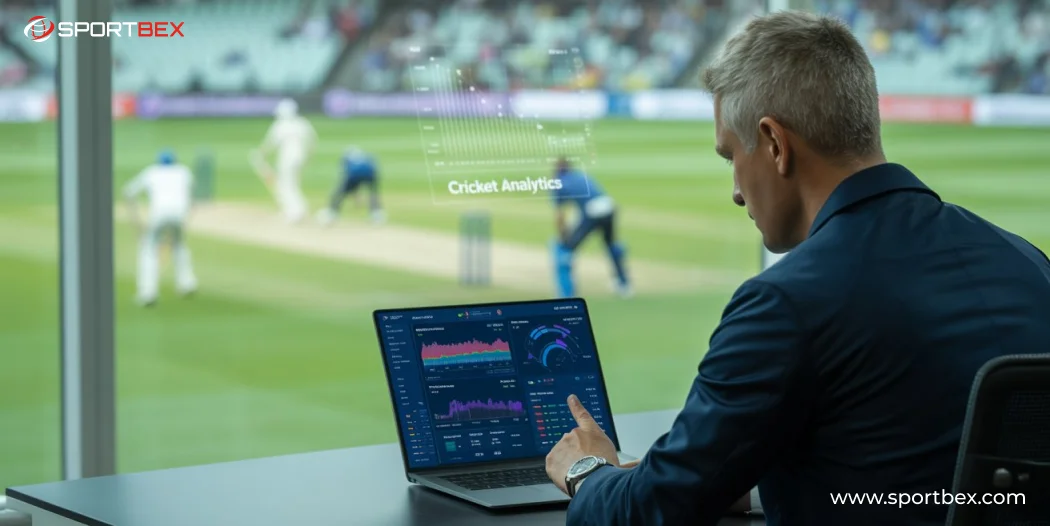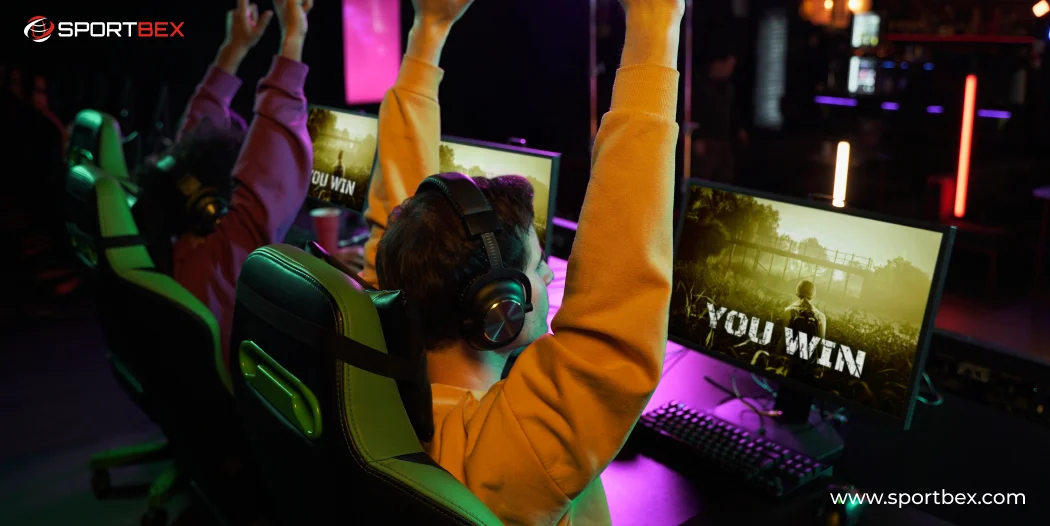Hockey is a fast and competitive sport where every movement on the field or rink can impact the outcome of a game. Success in hockey relies on skill, strategy, teamwork, and understanding how each player is performing. Coaches and teams are always searching for ways to improve, and hockey player tracking has become a key tool in achieving that.
With the help of hockey analytics software and tools like a fantasy hockey API, teams can collect accurate data to make informed decisions that enhance both individual skills and team strategies. By analyzing player performance evaluation, coaches can identify strengths, work on weaknesses, and develop personalized training plans that help players perform better and reduce the risk of injuries.
Hockey player tracking also helps teams track team performance metrics, making it easier to optimize lineups, plan strategies, and improve overall teamwork. This technology has become an essential part of modern hockey, providing insights that allow teams to make data-driven decisions and play smarter.
In this blog, we will explore what hockey player tracking is, how it improves individual and team performance, and share examples of hockey teams that have successfully used this technology. We will also explain how player tracking improves hockey team performance, giving coaches, players, and fans a deeper insight into how data is shaping the future of hockey.
What is Hockey Player Tracking?
Hockey player tracking is a technology-driven system that captures precise movement and performance data of players on the ice using wearable sensors, cameras, and smart pucks.
These systems monitor everything from skating speed and shot mechanics to player positioning, heart rate, and impacts during play. Unlike traditional statistics, tracking Sports technology gathers millions of three-dimensional data points per game, allowing coaches and analysts to explore every nuance in player and team behavior.
The main components of hockey player tracking include:
- Wearable sensors in jerseys and equipment
- Infrared cameras positioned above the rink
- Smart pucks with embedded chips
- Centralized software dashboards for performance analysis
Benefits of Hockey Player Tracking for Individual Performance
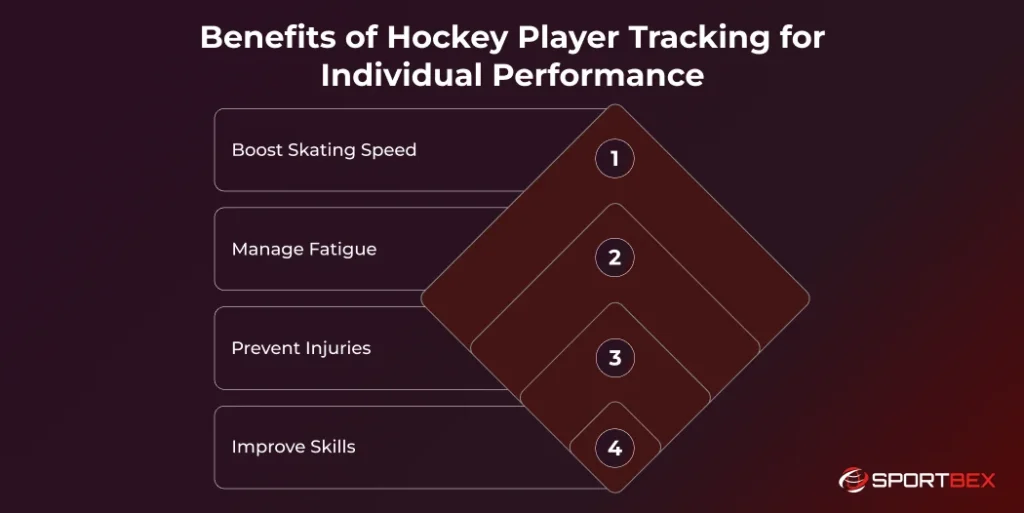
Skate Faster
Hockey player tracking allows athletes to monitor their skating speed and acceleration during both practices and games. By identifying areas where they slow down or lose momentum, players can focus on improving those aspects.
Tracking speed over time also provides insights into progress, helping players set measurable goals and track improvement. With consistent monitoring, players can refine their technique, build endurance, and maintain high performance throughout the game, giving them a competitive edge during critical moments.
Save Energy
Player tracking helps athletes understand how much energy they are using during games and training sessions. By monitoring exertion levels, players can learn when to push hard and when to conserve energy. This ensures they remain effective and alert throughout the match, especially during long shifts or intense plays.
Proper energy management helps players maintain consistent performance, reduce fatigue, and avoid burnout, ultimately benefiting team performance metrics. Using real-time data from a Reliable Ice Hockey API allows players and coaches to make informed decisions about energy use during games and practices.
Avoid Injuries
Player tracking is crucial for injury prevention. Wearable sensors and performance data can detect fatigue, strain, or overuse before they turn into serious injuries. By adjusting training intensity or adding rest periods based on this data, players can reduce the risk of muscle strains, joint issues, and other common hockey injuries.
Staying healthy ensures that players can participate consistently throughout the season, maintain peak physical condition, and contribute effectively to their team. Long-term injury prevention also allows players to develop their skills steadily without setbacks, improving both individual and team performance.
Get Better at Skills
Tracking technology provides detailed insights into player skills such as puck handling, positioning, and movement patterns. Players can see where they excel and where improvement is needed, allowing them to focus their practice on specific areas. This targeted approach helps refine techniques and makes players more effective during games.
Over time, improving these skills builds confidence and enhances decision-making on the ice. Players become more strategic, react faster to in-game situations, and make better contributions to the team, ultimately boosting both individual and overall team performance and demonstrating clearly how player tracking improves hockey team performance.
How Hockey Player Tracking Boosts Team Performance
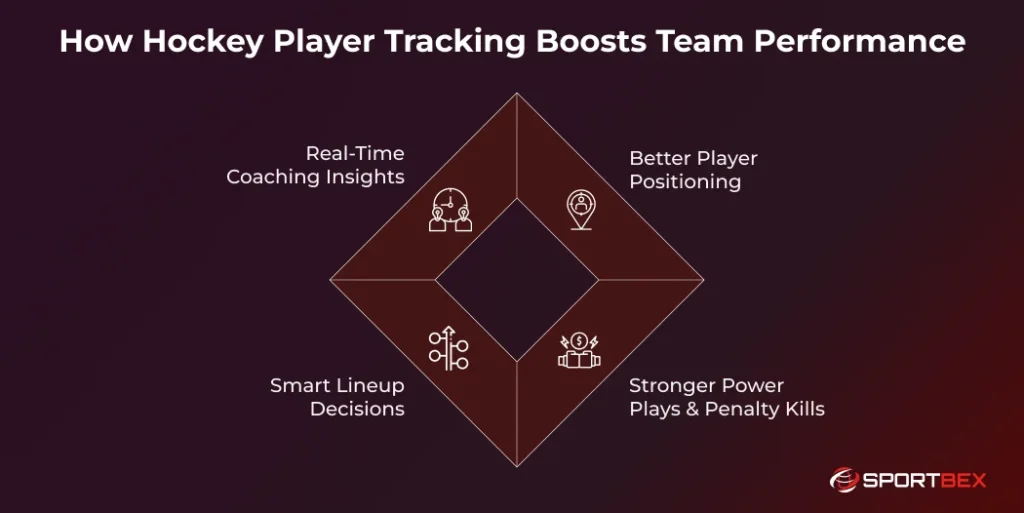
Real-Time Coaching Insights
Hockey player tracking provides coaches with instant access to game data, such as skating distance, zone time, and shot speed. By monitoring these stats in real time, coaches can make quick adjustments during the game, like changing tactics or rotating players to respond to opponents.
With real-time insights, coaches can also identify trends over the course of the match, such as which players are fatigued or which strategies are working best. This data-driven approach helps the team perform more efficiently and make smarter decisions under pressure, improving overall game outcomes.
Better Player Positioning
Tracking player movements with sensors and 3D cameras gives coaches a clear view of where each player is on the ice at all times. By analyzing positional data and heatmaps, coaches can ensure players are in the right spots for both offense and defense.
Better positioning also helps the team respond effectively to changing game situations. Players know where to move, anticipate opponents’ actions, and cover gaps, which enhances teamwork and overall efficiency. This leads to smoother plays, stronger defense, and a more cohesive unit on the ice.
Stronger Power Plays & Penalty Kills
Player tracking helps teams analyze power play and penalty kill situations in detail. By reviewing each player’s position, movement speed, and coverage, coaches can identify areas for improvement and adjust strategies to maximize advantages.
Tracking data also allows coaches to experiment with different formations and tactics during practice, improving efficiency in real games. Over time, this leads to better coordination, faster decision-making, and higher success rates during power plays and penalty kills, giving the team a competitive edge.
Smart Lineup Decisions
Hockey tracking software provides detailed insights into player fitness, impact data, and recent game performance. Coaches can use this information to make informed lineup choices rather than relying on guesswork. This ensures the team is always fielding the strongest and most prepared players for each shift.
Using analytics for lineup decisions also helps manage player workload and avoid fatigue. By rotating players effectively based on performance data, the team maintains high energy levels and peak performance throughout the game, improving overall results and consistency.
Real-World Examples of Hockey Teams Using Player Tracking
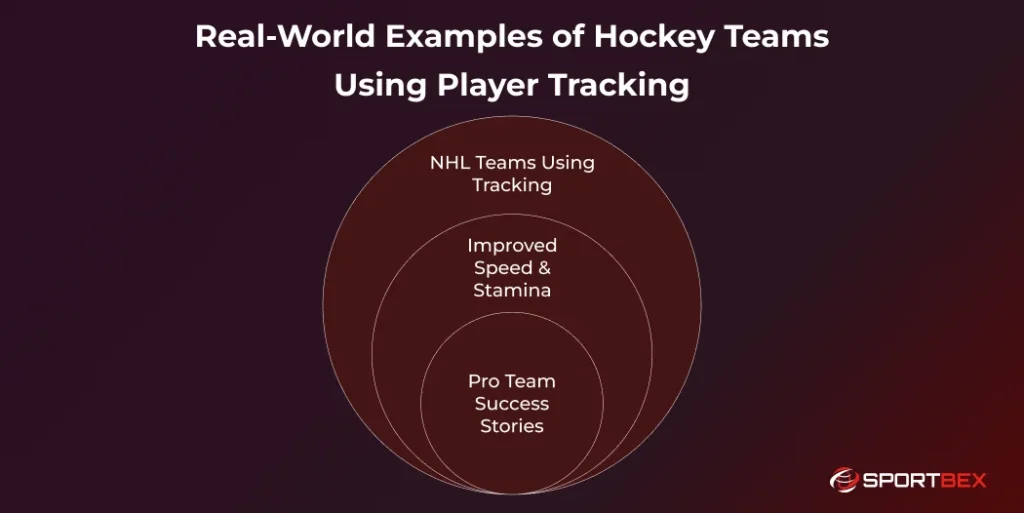
NHL Teams Using Tracking
The NHL hockey league has led the way in player tracking, implementing puck and player tracking technology across all arenas since the 2021-22 season. Sensors embedded in jerseys and pucks, combined with infrared cameras, collect nearly one million 3D data points per game.
Teams now use platforms like SMT’s OPTICS and SAP to visualize this data in real time. Coaches can adjust strategies during games, track player performance evaluation, and create custom displays and leaderboards, allowing both teams and fans to better understand player contributions and team dynamics.
Improved Speed & Stamina
Many NHL teams use tracking systems to monitor player speed, stamina, and overall efficiency on the ice. By analyzing skating patterns, zone coverage, and fatigue indicators, coaches can adjust shifts and rotations to keep players fresh and performing at their best.
Tracking also allows teams to identify areas for improvement in individual players, helping athletes focus on specific aspects like endurance, acceleration, and consistency. Over time, these insights help the team maintain high energy levels throughout games, enhancing team performance metrics and giving them a competitive advantage.
Pro Team Success Stories
Elite hockey organizations use player tracking not just for fitness or training, but also for roster management and tactical planning. Teams like the Pittsburgh Penguins and Toronto Maple Leafs have leveraged real-time analytics to gain an edge in scouting, game analysis, and in-game decisions.
These systems allow coaches to make smarter strategic choices and build stronger lineups based on performance data. By relying on objective metrics rather than guesswork, teams can improve both individual and collective performance, contributing to successful championship runs and long-term competitiveness.
Get a Ready-Made Platform On Rent.
Get Started Today
Conclusion
Hockey player tracking has become a cornerstone of modern hockey, helping players and teams perform at their best. With wearable sensors, smart pucks, and hockey analytics software, athletes can monitor speed, stamina, positioning, and overall performance. This allows them to improve skills, prevent injuries, and maintain consistency throughout the season.
For teams, tracking data provides real-time insights that improve player positioning, strengthen power plays and penalty kills, and support smarter lineup decisions. By analyzing team performance metrics and player performance evaluation, coaches can make informed decisions that give the team a clear competitive edge.
Professional teams in the NHL and other leagues are already reaping the benefits. Tracking technology optimizes fitness, enhances teamwork, and improves both individual and collective performance. Understanding how player tracking improves hockey team performance has become essential for success in modern hockey.
If you want your team to reach its full potential, adopting hockey player tracking solutions and leveraging the right analytics platforms is crucial. These tools can transform training, strategy, and game-day decisions, helping your team perform smarter, stronger, and more efficiently.
Frequently Asked Questions
Hockey player tracking is a technology that uses wearable sensors, smart pucks, and cameras to collect detailed data on player movements, speed, stamina, and positioning. It helps coaches and teams analyze performance and make smarter decisions during games and training.
By monitoring speed, energy levels, skills, and fatigue, tracking technology allows players to refine techniques, prevent injuries, and maintain consistent performance. It helps players focus on their strengths and improve weaknesses effectively.
Player tracking provides real-time insights into team dynamics, positioning, and strategy. Coaches can optimize lineups, improve power plays and penalty kills, and make data-driven decisions that enhance overall team performance.
Key tools include wearable sensors in jerseys, smart pucks with embedded chips, infrared cameras, and centralized hockey analytics software dashboards. These tools collect and visualize data for both players and coaches.
Many NHL teams, including the Pittsburgh Penguins and Toronto Maple Leafs, use player tracking to improve team performance metrics, monitor player fitness, and optimize game strategies.
Recent Blog
How Data Analytics Is Transforming Cricket Strategy
October 23, 2025
 7 min
7 min
Top 10 Esports Betting Sites to Play
October 23, 2025
 9 min
9 min




